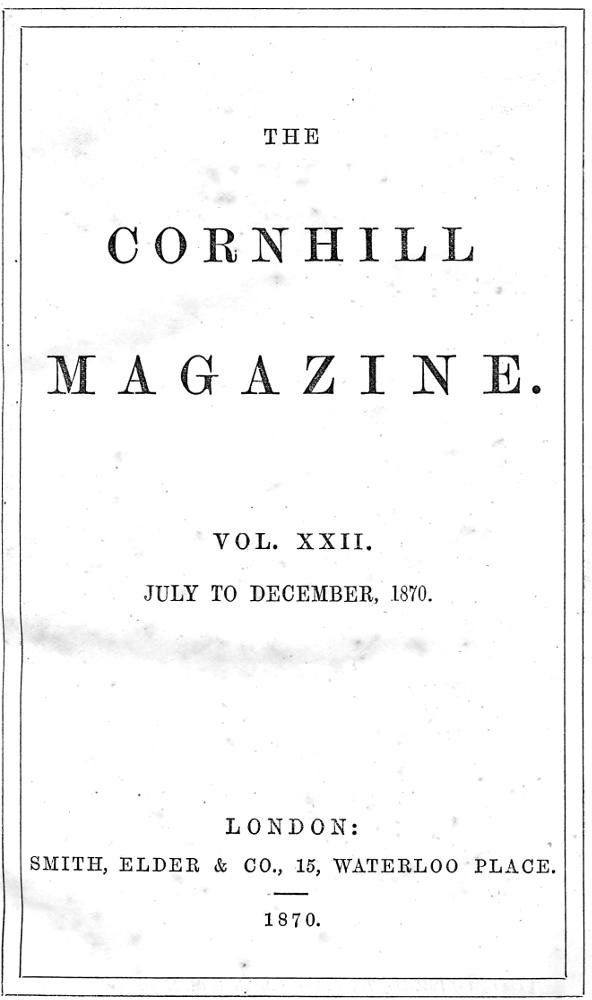

Initial letter B: Dick shook with laughing while the other read out the paragraph by Sir Luke Fildes; engraver, Swain. Eighth initial-letter vignette for Charles Lever's Lord Kilgobbin, from the May 1871 number of the Cornhill Magazine, p. 513 in Vol. XXIII. 7.6 cm by 5 cm (3 by 2 inches), framed. Part 8, for Chapter XXIX, "On a Visit at Kilgobbin." The wood-engraver responsible for this thumbnail illustration was Joseph Swain (1820-1909), noted for his engravings of Sir John Tenniel's cartoons in Punch. [Click on the image to enlarge it; mouse over links.]

The title-page for Volume XXIII of the Cornhill Magazine (January to June, 1871).
This eighth vignette is based on the opening passage in Ch. 29, "On a Visit at Kilgobbin"
"I came up with the postboy, and took his letters to save him a couple of miles. Here’s one for you, I think from Atlee; and this is also to your address, from Dublin; and here’s the last number of the Pike, and you’ll see they have lost no time. There’s a few lines about you. "Our readers will be grateful to us for the tidings we announce to-day, with authority — that Richard Kearney, Esq., son of Mathew Kearney, of Kilgobbin Castle, will contest his native county at the approaching election. It will be a proud day for Ireland when she shall see her representation in the names of those who dignify the exalted station they hold in virtue of their birth and blood, by claims of admitted talent and recognised ability. Mr. Kearney, junior, has swept the university of its prizes, and the college gate has long seen his name at the head of her prizemen. He contests the seat in the National interest. It is needless to say all our sympathies, and hopes, and best wishes go with him."'
Dick shook with laughing while the other read out the paragraph in a high-sounding and pretentious tone.
"I hope," said Kearney at last, "that the information as to my college successes is not vouched for on authority."
"Who cares a fig about them? The phrase rounds off a sentence, and nobody treats it like an affidavit." [Cornhill, Vol. XXIII, 513]
Commentary: How Dick responds to the new notion of a political career
Luke Fildes has given us several representations of the headstrong Richard (Dick) Kearney, who appears in a total of four full-page wood-engravings: 2, 5, 7, and 18 in volume. Although his father believes that the financial constraints he has placed on his pleasure-loving son are merely careful budgeting, Dick interprets his father's cost-cutting measures, including keeping him on a tight fiscal leash during his studies at Trinity College, Dublin, as mean-spirited parsimony. Only recently by examining the Castle accounts which his sister Kate manages has he learned about the family's loss of rent revenues ever since 1864. He has yearned to lead the life of an urban aristocrat, attending balls, splendid society dinners, fetes, picnics, and horse-races. But now comes a sea change: ironically, the nationalist Daniel Donogan's encouraging Dick to run as a Whig in the forthcoming by-election for the Member of Parliament for King's County may give Dick a political career and a higher purpose that he has never before considered.
In the miniature illustration, Dick, still in his dressing gown, reads the newspaper's announcement of his candidacy with some levity, but his interlocutor, having just come in from a morning constitutional on the bog, seems in deadly earnest. Oddly enough, Fildes has not attempted to make Donogan look much like Lever's description of him earlier:
He was a short, thick-set man with a profusion of yellowish hair, which, divided in the middle of the head, hung down on either side to his neck — beard and moustache of the same hue, left little of the face to be seen but a pair of lustrous blue eyes, deep-sunken in their orbits, and a short wide-nostrilled nose, which bore the closest resemblance to a lion’s. Indeed, a most absurd likeness to the king of beasts was the impression produced on Kearney as this wild-looking fellow bounded forward, and stood there amazed at finding a stranger to confront him. [Chapter XXVI, "Dick Kearney's Chambers," 158]
Scanned images and text by Philip V. Allingham. [You may use these images without prior permission for any scholarly or educational purpose as long as you (1) credit the person who scanned them and (2) link your document to this URL in a web document or cite the Victorian Web in a print one.]
Bibliography
Lever, Charles. Lord Kilgobbin. The Cornhill Magazine. With 18 full-page illustrations and 18 initial-letter vignettes by S. Luke Fildes. Volumes XXII-XXV. October 1870-March 1872.
Lever, Charles. Lord Kilgobbin: A Tale of Ireland in Our Own Time. Illustrated by Sir Luke Fildes, R. A. London: Smith, Elder, 1872; rpt., Chapman and Hall, 1873. 3 vols.
Lever, Charles. Lord Kilgobbin. Illustrated by Sir Luke Fildes. Novels and Romances of Charles Lever. Vols. I-III. In three volumes. London: Smith, Elder, 1872, Rpt. London: Chapman & Hall, 1873, in a single volume. Project Gutenberg. Last Updated: 19 August 2010.
Stevenson, Lionel. Chapter XVI, "Exile on the Adriatic, 1867-1872." Dr. Quicksilver: The Life of Charles Lever. New York: Russell and Russell, 1939; rpt. 1969. Pp. 277-296.
Sutherland, John A. "Lord Kilgobbin." The Stanford Companion to Victorian Fiction. Stanford, Cal.: Stanford U. P., 1989, rpt. 1990, 382.
Created 8 June 2023 Updated 24 June 2023